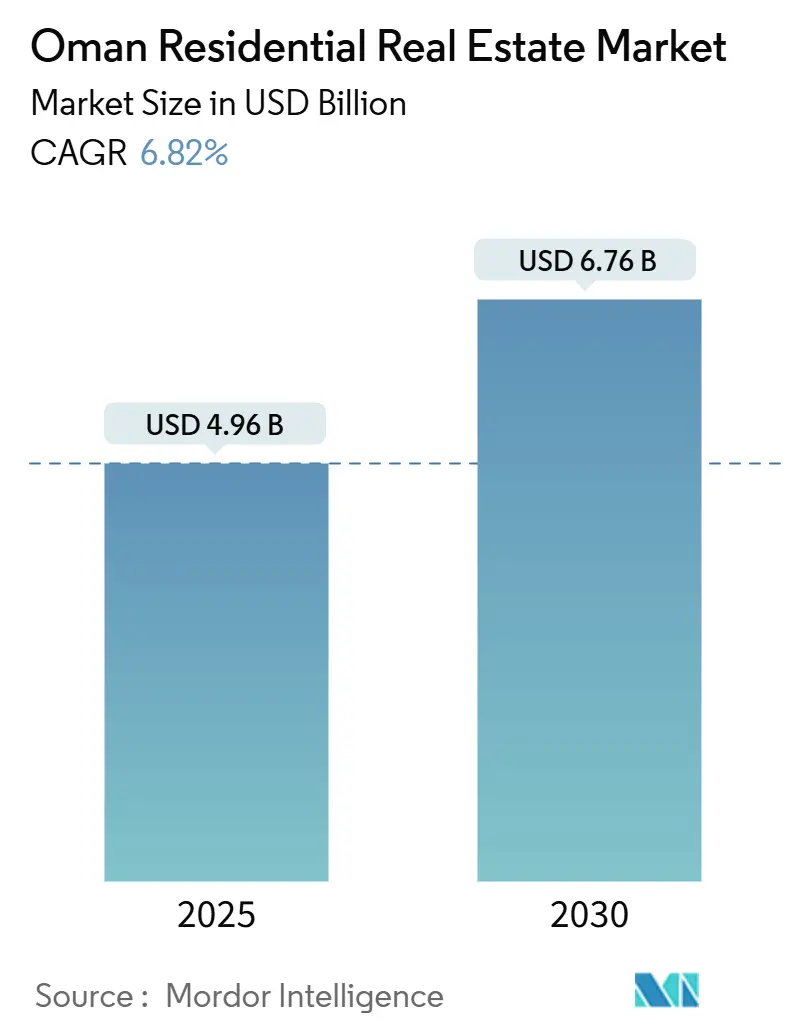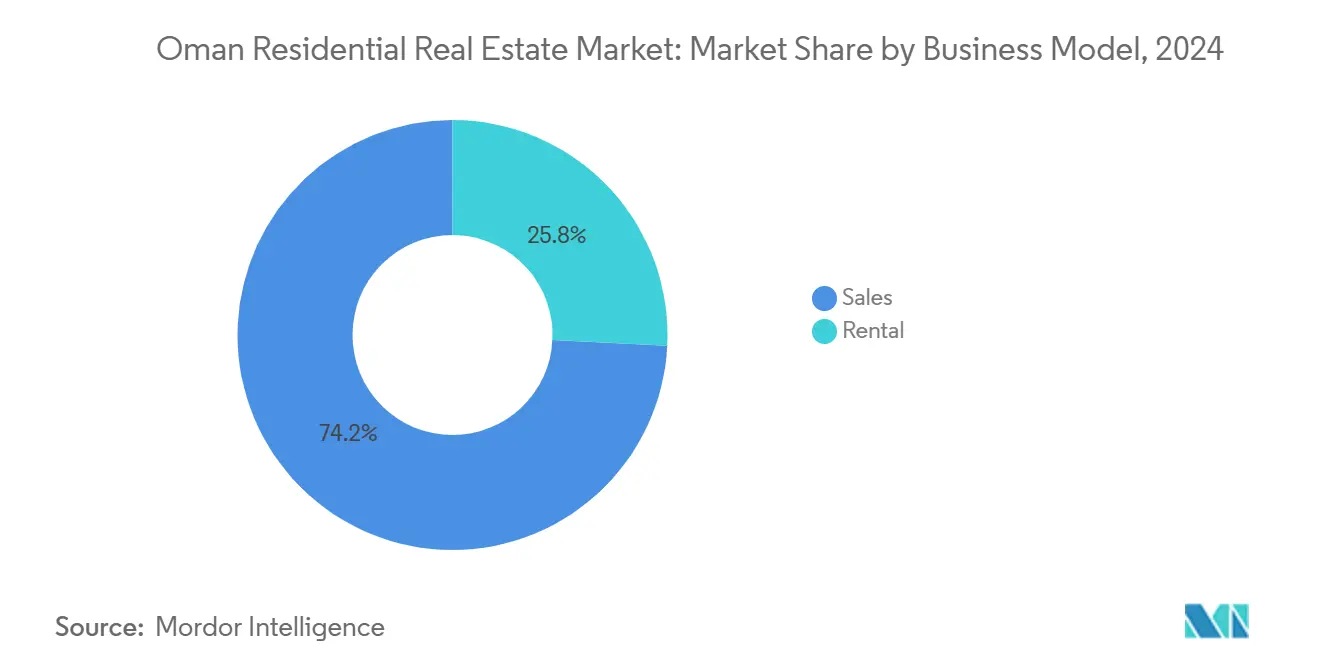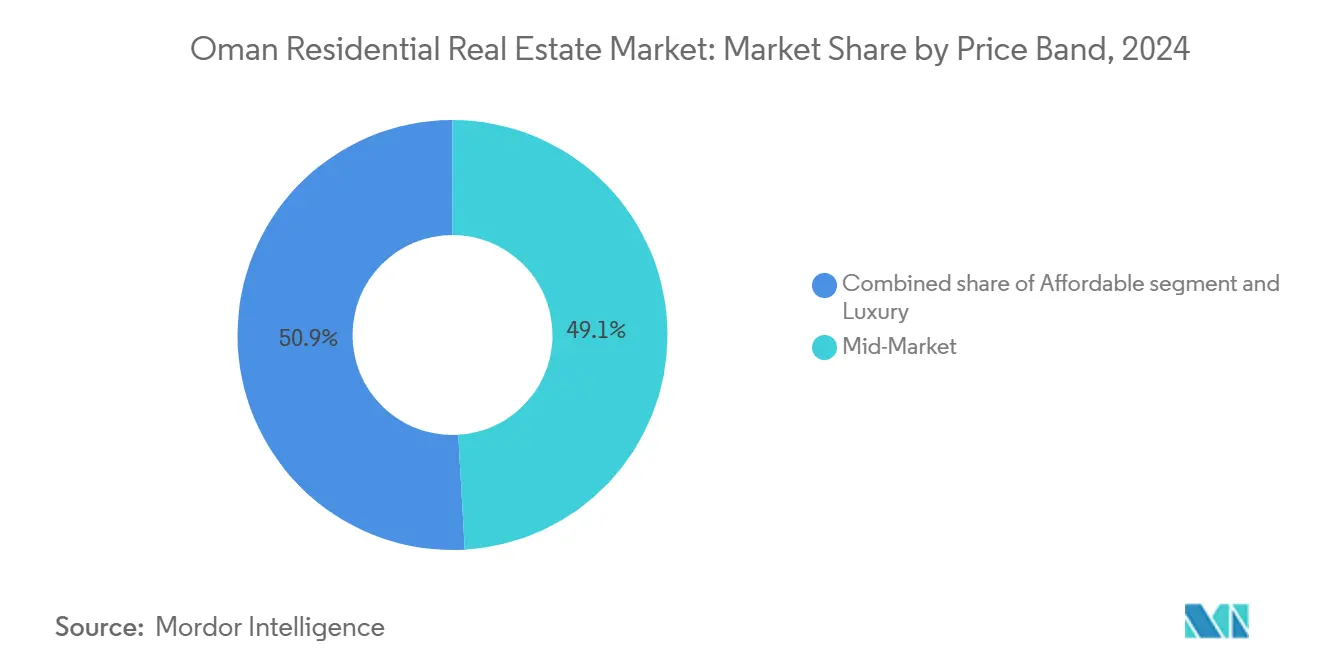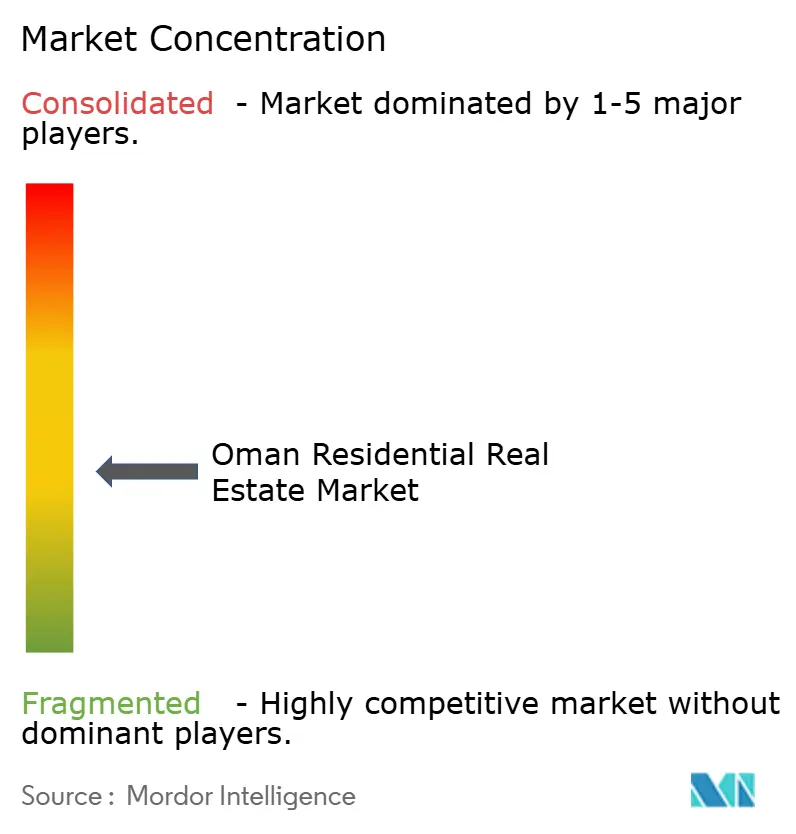
Oman Residential Real Estate Market Analysis by Mordor Intelligence
The Oman residential real estate market size stood at USD 4.96 billion in 2025 and is forecast to reach USD 6.76 billion by 2030, translating into a 6.82% CAGR over the period. The expansion is underpinned by Vision 2040 infrastructure spending, a steady population increase, and fresh freehold rules that widen the eligible buyer base. Large-scale master plans such as Sultan Haitham City and New City Salalah are accelerating land absorption, while lower transaction fees encourage first-time purchasers. Developers are also pushing smart-home features and green building standards to capture demand from younger households, a move that differentiates offerings and supports price resilience. Sustained mortgage growth—supported by the banking sector’s rising appetite for longer tenors—keeps the sales pipeline predictable, even as rental yields between 5.6% and 8.3% remain attractive relative to regional peers.
Key Report Takeaways
- By business model, the sales segment led with 74.2% of the Oman residential real estate market share in 2024, while rentals are projected to post the fastest 7.39% CAGR through 2030.
- By property type, villas held 67.4% of the Oman residential real estate market share in 2024; apartments are on track for the highest 7.51% CAGR to 2030.
- By price band, mid-market homes captured 49.1% share of the Oman residential real estate market size in 2024, whereas luxury units are forecast to expand at a 7.71% CAGR between 2025-2030.
- By mode of sale, primary transactions accounted for 54.7% of the Oman residential real estate market size in 2024 and are advancing at a 7.44% CAGR over the outlook period.
- By city, Muscat commanded 47.9% revenue share in 2024; Dhofar is set to record the quickest 7.97% CAGR through 2030.
Oman Residential Real Estate Market Trends and Insights
Drivers Impact Analysis
| Drivers | % Impact on CAGR Forecast | Geographic Relevance | Impact Timeline |
|---|---|---|---|
| Young, expanding population fuels household formation | +1.8% | Muscat and key secondary cities | Medium term (2-4 years) |
| Urban master plans create new residential hubs | +1.5% | Muscat, Salalah, Dhofar | Long term (≥ 4 years) |
| Housing programs and subsidies widen ownership access | +1.2% | Nationwide integrated neighborhoods | Long term (≥ 4 years) |
| Expatriate demand rises in freehold and ITC zones | +0.9% | Muscat, Al Mouj, SEZs | Medium term (2-4 years) |
| Lifestyle shift toward modern apartments and gated communities | +0.7% | Urban centers | Short term (≤ 2 years) |
| Source: Mordor Intelligence | |||
Growing Housing Demand Supported by a Young, Expanding Population
A median age below 32 and a 15% population jump over five years are steadily enlarging the pool of first-time buyers. Ministry data show 500,000 active housing requests and 125,000 families lacking suitable dwellings, underscoring an urgent supply gap. The government has reacted with 22 integrated residential-neighborhood projects that fold in schools, clinics, and green areas to match rising lifestyle expectations. Simultaneously, an 8% rebound in expatriate numbers during 2024 revived rental absorption in Muscat’s core districts. Modest but targeted job programs—300-400 positions annually—add incremental purchasing power to the Oman residential real estate market[1]Husam Al-Mukhaini, “Annual Housing Requests and Allocations Report 2024,” Ministry of Housing and Urban Planning, mohup.gov.om.
Government Housing Programs and Subsidies Improving Affordability
In 2024, the Social Housing Program supported 1,382 families, while the “Choose Your Land” scheme allocated 25,000 serviced plots. Registration fees fell from 2% to 1% for citizens, and Islamic-finance charges were trimmed, jointly lowering entry costs. A USD 1.3 billion public-private partnership envelope mobilizes private capital for low- and mid-income communities, securing faster build-out without fiscal overstretch. Preferential land grants to marriage-fund beneficiaries further streamline the ownership path for young couples. Together, these levers expand the addressable Oman residential real estate market[2]Fatma Al-Zadjali, “Budget Execution Update 2024,” Ministry of Finance, mof.gov.om.
Urban Development Plans Creating New Residential Hubs
The Greater Muscat Structural Plan maps land use across 1,360 km² to 2040, earmarking transit-oriented corridors and mixed-use clusters. Al Khuwair Downtown, a USD 2.6 billion waterfront project, integrates offices, retail, and 4,000 homes, showcasing greener design and shorter commute times. In Dhofar, New City Salalah spans 7.3 km² with 12,000 housing units and climate-resilient drainage, indicating how secondary cities are absorbing spillover demand. Vision 2040’s USD 85 billion project pipeline also lists five future cities, signaling a long runway for the Oman residential real estate market[3]Ahmed Al-Habsi, “Greater Muscat Structural Plan 2040 Summary,” Muscat Municipality, muscatmun.gov.om.
Rising Interest from Expatriates via Freehold Zones and ITCs
April 2025 regulations allow full ownership for non-Omani individuals in Special Economic Zones, building on earlier Integrated Tourism Complex provisions. Foreign purchase transactions climbed 19.4% year-on-year in 2024, and the First-Class Residency Card ties a five-year visa to a USD 1.3 million property outlay. New touristic districts beyond Al Mouj enlarge the inventory that foreigners can legally buy, while SEZAD’s asset base of USD 54.6 billion validates investor confidence. These incentives widen the Oman residential real estate market’s global catchment.
Restraints Impact Analysis
| Restraints | % Impact on CAGR Forecast | Geographic Relevance | Impact Timeline |
|---|---|---|---|
| High construction costs and skilled-labor shortages | -1.1% | Nationwide, large projects | Short term (≤ 2 years) |
| Oil-revenue dependence causing demand fluctuations | -0.8% | Nationwide | Medium term (2-4 years) |
| Regulatory and procedural delays | -0.6% | Nationwide, mixed-use schemes | Medium term (2-4 years) |
| Source: Mordor Intelligence | |||
High Construction Costs and Limited Skilled Labor
Input prices climbed in 2024 as steel and cement import costs tracked global commodity swings, squeezing contractor margins on fixed-price contracts. Omanization quotas complicate hiring pipelines, and visa clearances for specialists often extend beyond eight weeks. The construction sector added USD 9 billion to GDP in 2023, but must now stretch to deliver a USD 85 billion project backlog. Early adopters of 3D printing note 30% material savings, hinting at a partial offset to escalating costs. Overall, execution risk mildly tempers the Oman residential real estate market growth.
Economic Dependence on Oil Revenues
Oil still funds close to 65% of fiscal receipts, so budgeted housing programs track Brent-price swings. While non-hydrocarbon GDP advanced 3.7% in 2024, any extended crude-price slump could trim infrastructure outlays and cool buyer sentiment. IMF stress tests flag banks’ 17.1% real-estate lending exposure as a watch point should prices soften. A rising sovereign net-asset position provides a short-term buffer, yet deeper diversification will determine long-term stability for the Oman residential real estate market.
Segment Analysis
By Business Model: Sales Dominance with Rental Acceleration
Sales held 74.2% of the Oman residential real estate market share in 2024 on the back of subsidized mortgages and lower transaction fees. Mortgage values jumped 44.8% year-on-year to USD 5.5 billion, even as contract counts dipped, implying larger ticket sizes. Buy-to-let investors from neighboring GCC economies remain active, lured by tax-free rental income and 5%–8% gross yields. The rental segment’s 7.39% CAGR outlook reflects rebounding expatriate inflows and the build-out of Integrated Tourism Complexes that bundle hospitality and residential assets.
Developers are experimenting with rent-to-own contracts that convert monthly leases into down-payments, a mechanism that broadens affordability without over-leveraging households. Digital tenancy platforms enhance transparency on lease terms and enable real-time inventory tracking, shortening vacancy periods. Corporate leasing demand also shows promise as multinational firms reopen regional offices, adding a new stripe of long-term tenants. Altogether, these dynamics point to a more balanced Oman residential real estate market over time.

By Property Type: Villas Lead While Apartments Gain Momentum
Villas retained a 67.4% Oman residential real estate market share in 2024, underlining cultural preferences for larger footprints and privacy. Projects such as the Al Ahlam District in Sultan Haitham City offer 47 energy-efficient villas equipped with solar rooftops and gray-water recycling, bringing sustainability into the luxury segment. Yet apartments post the stronger 7.51% CAGR, buoyed by urban land scarcity and demand for lock-and-leave lifestyles. Pipeline launches, including the six-tower Yenaier Residences, promise more than 1,200 units by 2027, swelling the apartment slice of the Oman residential real estate market size.
Smart-apartment deployments use IoT sensors to cut energy usage by 25%, an attractive feature for tenants amid rising utility tariffs. Meanwhile, mixed-use icons such as AIDA in Yiti will knit 3,500 residences with hotels, retail, and an 18-hole golf course, blurring traditional property boundaries. In the medium term, villas are expected to maintain value defensiveness, whereas apartments will underpin volume acceleration.
By Price Band: Mid-Market Stability with Luxury Premium Growth
Mid-market listings sat at 49.1% of the Oman residential real estate market size in 2024, serving a broad base of salaried nationals and expatriate professionals. Average ticket prices between USD 250,000 and USD 400,000 remained within reach thanks to subsidies on registration and easing down-payment norms. The luxury tier, priced above USD 650,000, is forecast to grow at a 7.71% CAGR, energized by high-net-worth GCC investors seeking coastal second homes cheaper than Dubai. Freehold villa plots in Muscat’s Al Mouj sell for up to USD 1.3 million yet still undercut regional benchmarks by 20%–30%.
Eco-luxury trends, including net-zero energy design and organic landscaping, are reshaping the upper end and broadening appeal to ESG-minded foreign buyers. At the opposite end, the Sustainable City-Yiti targets middle-income households with a promise of 100% renewable power and zero waste. These bifurcated strategies keep both value-driven and aspirational buyers engaged in the Oman residential real estate market.

Note: Segment shares of all individual segments available upon report purchase
By Mode of Sale: Primary Sales Drive Growth with Secondary Maturation
Primary deals made up 54.7% of the Oman residential real estate market share in 2024, thanks to fresh master-plan launches and quicker land-title approvals—SEZAD now processes usufruct applications in 5 days, down from 30. Flagship projects, including Sultan Haitham City’s USD 2.6 billion first phase, feed a robust off-plan funnel. Secondary trading is maturing as early investors monetize gains; real-estate digital registry “Amlak” logged 133,000 transfers in 2024, cutting paperwork times by half.
Price dispersion became more visible: Muscat apartment values slipped 12.9% year-on-year, whereas villa prices rose 2.5%, reflecting divergent demand pools. Regional arbitrage also surfaced, with land in North Al Batinah appreciating 18.8% as industrial expansion spilled into housing. This two-track performance creates new risk-adjusted opportunities across the Oman residential real estate market.
Geography Analysis
Muscat commanded 47.9% of the 2024 transaction value, cementing its role as the administrative and financial hub of the Oman residential real estate market. The Greater Muscat Plan meshes public transit with density nodes to keep commute times under 30 minutes, a quality-of-life metric that sustains buyer interest. Digital city services—from e-approvals to unified maintenance portals—improve municipal responsiveness and underpin property values. Ongoing migration from Ruwi and Muttrah toward newly minted districts such as Al Khuwair reflects preferences for modern infrastructure and walkable mixed-use clusters.
Dhofar is the fastest-growing pocket, set to post a 7.97% CAGR through 2030. New City Salalah will roll out 5,827 residential units in its first tranche, targeting a permanent population of 60,000. A 6-kilometer public beach, extensive mangrove restoration, and flood-resilient drainage fortify the development against climate risks. Seasonal tourism peaks align with the Khareef monsoon, lengthening occupancy cycles for investors seeking steady cash flow within the Oman residential real estate market.
Musandam and the rest of Oman are also on the government’s decentralization radar. Each governorate now receives USD 52 million annually for community upgrades, double the prior allocation. The Palm Hills project in Khasab reserves 25% of its 650 units for foreign buyers, introducing a novel demand segment. Royal Decree 36/2022 empowers local authorities to fast-track permits, accelerating the pace at which smaller cities can absorb migration from Muscat. Collectively, these regional efforts diversify the geographical base of the Oman residential real estate market.
Competitive Landscape
Roughly 90 licensed developers compete across the Oman residential real estate industry, making the field moderately fragmented. OMRAN Group’s joint venture with Saudi-based Dar Al Arkan on the USD 1.5 billion AIDA resort underscores a trend toward cross-border capital pools that share design expertise and risk. Public-private partnership templates now standardize land-lease terms, tenure rights, and utility responsibilities, lowering barriers for new entrants while maintaining governance clarity.
Digital tools are sharpening competitive edges. Early adopters of building information modeling report 20% faster design iterations, while 3D-printed elements shorten villa shell timelines by 30 days. The Oman Endowment Foundation’s profit-sharing structures introduce a social-impact layer, blending commercial returns with community development. Smart-home packages bundled into mortgages increase customer stickiness and enable developers to command slight price premiums within the Oman residential real estate market.
Regulatory tightening raises the bar on quality. Mandatory green-building codes phase in from 2026, compelling material efficiency and thermal standards. Developers investing in compliance ahead of schedule will likely win institutional buyers seeking ESG-aligned assets. Meanwhile, secondary-city specialists enjoy lower land costs and loosened zoning caps, allowing them to underprice Muscat peers without sacrificing margins. The competitive narrative, therefore, revolves around capital depth, technology adoption, and geographic focus rather than price alone.
Oman Residential Real Estate Industry Leaders
-
Al Mouj Muscat
-
Al Raid Group
-
Wujha Real Estate
-
Al-Taher Group
-
Maysan Properties SAOC
- *Disclaimer: Major Players sorted in no particular order

Recent Industry Developments
- February 2025: The Ministry of Housing and Urban Planning signed eight partnership agreements worth USD 176.8 million, covering 1.7 million m² and more than 1,300 housing units to bolster social stability.
- February 2025: Sarooj Oasis opened sales in Sultan Haitham City, furthering the model-community vision with mid-rise blocks and extensive parkland.
- January 2025: Adanté Realty launched Yenaier Residences—six towers offering studios to penthouses with freehold rights for all nationalities, reflecting luxury momentum.
- January 2025: National Bank of Oman inked MoUs with Zain Property Development and Adrak Developers to finance Hai Al Naseem and Husn Al-Zain, enhancing end-buyer affordability.
Oman Residential Real Estate Market Report Scope
Residential real estate is land built for people to live and cannot be utilized for commercial or industrial purposes. This happens when someone purchases land designated for residential use, which becomes real property and contains a wide range of potential homes, from houses to houseboats and neighborhoods ranging from the poorest slum to the wealthiest suburban development.
The residential real estate market in Oman is segmented by type (apartments and condominiums and villas and landed houses) and by key cities (Muscat, Dhofar, and Musandam). The report offers the market sizes and forecasts for the residential real estate market in Oman based on revenue in USD billion for the above segments.
A complete assessment of the residential real estate market in Oman includes an assessment of the economy and the contribution of sectors in the economy, a market overview, market size estimation for key segments, and emerging trends in the market segments in the report. Further, the report sheds light on the market trends like growth factors, restraints, and opportunities in this sector. The competitive landscape of the residential real estate market in Oman is depicted through the profiles of active key players.
| Sales |
| Rental |
| By Business Model | Sales |
| Rental |
Key Questions Answered in the Report
What is the current value of the Oman residential real estate market?
The Oman residential real estate market size is USD 4.96 billion in 2025.
How fast is the market expected to grow?
It is projected to expand at a 6.82% CAGR, reaching USD 6.76 billion by 2030.
Which region is growing the quickest?
Dhofar is forecast to post the fastest 7.97% CAGR, powered by New City Salalah.
Are foreigners allowed to buy homes in Oman?
Yes, April 2025 regulations grant freehold rights to non-Omanis in Special Economic Zones and Integrated Tourism Complexes.
What rental yields can investors expect?
Gross yields typically range between 5.6% and 8.3%, depending on property type and location.
Page last updated on:



